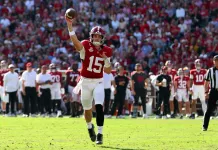Continuing a report from last week’s Point Spread Weekly on transitional betting systems in college football, I’m moving from personnel to statistical characteristics in determining which teams appear ready to improve or decline in 2021.
Among the most difficult things in handicapping college sports is evaluating teams from one season to the next. A lot of factors can affect a team’s strengths and how much different it might be from the previous season. Among these are personnel losses, coaching changes and momentum lost or gained. Adding to the difficulty is that many programs are taking players right out of their most recent recruiting classes and plugging them into starting spots.
Increasing the challenge for the upcoming season are the eligibility rules giving players another season due to COVID-19 and the fact that the number of games teams played last year varied widely, from as much as a full season to as few as two games. Many teams also played conference-only slates, leading to a schedule strength much different from normal. We’ll see how this impacts this week’s study as the statistical differences from the usual figures are noticeable.
In recent years, I have tried to quantify the signs of potential improvement or decline considering some year-to-year transitional situations. So let’s dive into statistics from last season that can best forecast a team’s upcoming prospects.
%%offer%
Can any statistics from the previous season predict the coming season?
Sometimes teams just catch consistently good or bad breaks in a given season that impact their records and spread success significantly. Let’s mine the data for anything that might help us find strong fade or follow teams for 2021.
— Over the last eight seasons, 46 teams have endured losing seasons despite outscoring their opponents. Of those, 14 brought back 13 or more starters, including the quarterback. The collective improvement of this group was about 13.3% SU. These teams were a profitable 52.9% ATS.
Potential improve teams for 2021: Penn State, Troy, UCLA, Wake Forest, Wyoming.
— Fifty teams over the last eight seasons have enjoyed winning seasons despite being outscored. Of those, 12 brought back 13 or fewer starters and turned to new starting quarterbacks. Only one team improved — by one win — and the collective decline was about 15.9% SU. This bunch included Michigan State and Utah State in 2020, and they combined to go 3-10 SU and ATS.
Potential decline teams for 2021: None in this season of super seniors, though Stanford came closest, returning 15 starters.
Turnover luck is an easy-to-recognize opportunity for spotting teams capable of improving or in danger of falling. For the last eight seasons, teams that had turnover ratios of -1.0 or worse per game improved by an 11.5% winning percentage the next season. Those that were in the -0.1 to -0.9 range improved by 3.8%. On the opposite side of the coin, teams with turnover ratios of %plussign% 1.0 or more dropped by 13.6%, while those in the %plussign% 0.1 to %plussign% 0.9 range were about 3.5% worse the next year. With this much data, we must study this further.
— Over the last six seasons, 11 teams went .500 or better against the spread despite having -1.0 or worse turnover differentials per game. Those teams bounced back the next season, improving by over 15%.
Potential improve team for 2021: Oregon.
— In the “there’s nowhere to go but up” category, 36 teams since 2013 have won two or fewer games in a season while enduring -1.0 or worse turnover ratios. Only three got worse, while the average win improvement was 2.0 per season. The SU win percentage upgrade was 17.2%, and the ATS improvement was 15.1%. Despite the mistake-prone play, the most dramatic improvement came from teams that brought back 15 or more starters. That group of 16 teams improved by 4.6 wins, a 24.3% SU winning percentage and 24.1% ATS.
Potential improve teams for 2021: Arizona, Maryland, Michigan State, Utah State.
— A potential land-mine system has affected teams coming off seasons in which they enjoyed positive 1.0 or better turnover differentials but are now starting fresh at quarterback. The 26 most recent teams that have fit this description have dropped by 1.8 wins the next campaign, representing a 20.8% plunge outright and 14% dip ATS. Furthermore, none of the 26 won more games the next season.
Potential decline teams for 2021: Clemson, Kentucky, Ohio State, Texas.
— It can be argued easily that the teams that got the luckiest the previous season had the best turnover differentials combined with the smallest point differentials. It can also be predicted that these teams are due for a fall when starting over. Historically, that is the case, as none of the last 15 teams to have a turnover differential of %plussign% 1.0 or better and points-per-game differential of %plussign% 12.0 or less with 14 or fewer starters returning improved their winning percentage the next season. The average decline was 2.6 wins for an average percentage drop of 23.1% outright and 7.1% ATS. Collectively, they were 45% ATS.
Potential decline teams for 2021: Kentucky.
Analyzing the quality of wins and losses from the previous season
A lot of prognosticators tout close wins or losses as motivation for a team heading into the next season. I’ll look at that as well as blowout wins and losses. I define close wins and losses as seven or fewer points and blowouts as 20 or more points.
— Experienced teams have shown a penchant for bouncing back. Coming off seasons in which they lost at least six games by 20 points or more, teams with at least 14 starters back have wiped the slate clean enough to improve by 3.8 wins the next season over the last eight years. This represents a 17.7% improvement outright and jump of 23.3% ATS.
Potential improve teams for 2021: Kansas, Louisiana-Monroe, Vanderbilt.
— Fifty teams over the last eight seasons have lost one or no games by 20 points or more in a season but still finished with a losing record. Of the 22 that brought back 14 or more starters the next season, only five finished with worse records. The average win improvement of this group was 2.5, good for a 16% jump.
Potential improve teams for 2021: Arizona, Baylor, California, Charlotte, Eastern Michigan, Florida International, Maryland, Michigan, Northern Illinois, New Mexico, Oregon State, Penn State, Purdue, Rice, Rutgers, Texas Tech, UCLA, Washington State, Wyoming.
— Over the last eight years, 29 teams have started new quarterbacks after a season in which they finished with a winning record despite suffering three or more losses of 20 points or more. Only five of those 29 improved the next season, with the average drop being 15.8%, or 2.9 wins.
Potential decline teams for 2021: None.
— As another sign of experienced teams being able to wipe the slate clean, only two of the last 37 qualifiers that failed to record a blowout win and were bringing back 16 or more starters got worse the next season. The average win gain was a whopping 2.2, good for an 18.7% bump. This group also recorded a 55.8% ATS mark.
Potential improve teams for 2021: Arkansas, California, Colorado, Colorado State, Eastern Michigan, Florida International, Hawaii, Illinois, Kansas, Louisiana-Monroe, Maryland, Michigan State, Middle Tennessee State, Mississippi State, Northern Illinois, NC State, Nebraska, New Mexico, Oregon State, Purdue, Rutgers, San Jose State, Southern Miss, Syracuse, UNLV, Utah, Utah State, Washington, Washington State.
— Fourteen teams have recorded seven or more blowout wins in a season, then changed coaches. Only one of the 14 got better the next season, by an average of 19%, or 2.7 wins.
Potential decline teams for 2021: None.
— Close losses can be a galvanizing factor for teams that stay the course. In fact, of the 21 teams over the last eight seasons that suffered five or more close losses and brought back their head coaches and at least half their starters, only two finished worse the next season. The average win improvement was 2.4, representing an 18.7% jump.
Potential improve teams for 2021: None.
— Not being tested by close losses can be a warning signal for inexperienced teams on the verge of dropping. Over the last eight seasons, 39 teams have won nine, 10 or 11 games while suffering zero or one close losses and brought back only half their starters or fewer. Of these, only three teams won more games the next season, with an average win drop of 3.5, a 22.4% slide.
Potential decline teams for 2021: BYU, Notre Dame.
— Close wins are often characterized as getting lucky. Teams that have a lot of them and then come back inexperienced are naturally expected to drop. Over the last eight seasons, 22 teams brought back 12 or fewer starters from a team that had five or more close wins the previous season. Only one was better the next season, with an average win drop of 2.6, a 14.8% plunge.
Potential decline teams for 2021: None.
— Subpar teams that experience zero close wins in a season also tend to improve, particularly when choosing to stay the course. In fact, 25 teams have finished under .500 and had zero close wins the year before, then brought back their starting QB, at least 12 total starters and their head coach and both coordinators. Of those, 21 finished better the next season. The average win bump was 2.6, a 21.2% surge.
Potential improve teams for 2021: Akron, Charlotte, East Carolina, Houston, Syracuse, Washington State.





